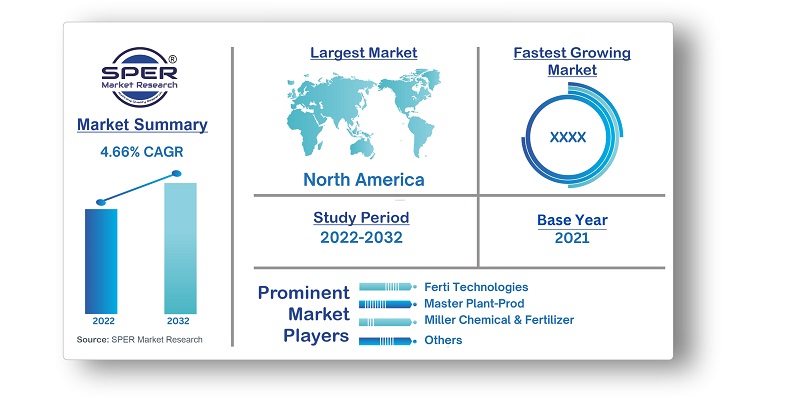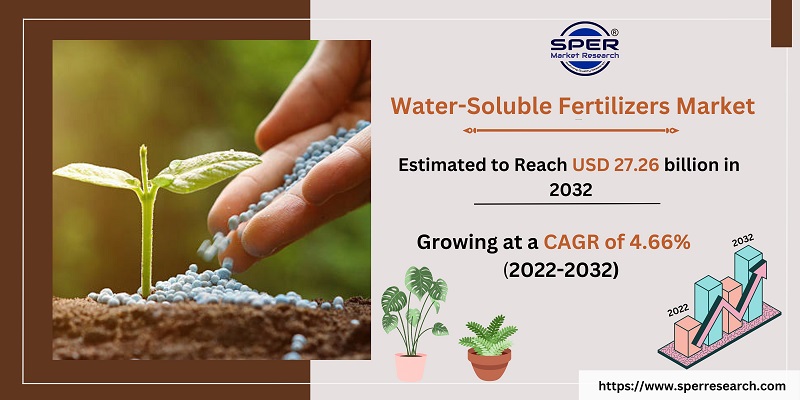
Water-Soluble Fertilizers Market Growth, Size, Trends, Revenue, Demand and Future Competition
Water-Soluble Fertilizers Market Size- By Form, By Product, By Crop Type, By Application- Regional Outlook, Competitive Strategies and Segment Forecast to 2032
| Published: Feb-2023 | Report ID: AGRI2304 | Pages: 1 - 242 | Formats*: |
| Category : Agriculture | |||
- In July 2022, Nutrien declared that it has signed a contract to buy the Brazilian business Casa do Adubo for almost $400 million. This deal consists of 10 distribution centers operating under the brand Agrodistribuidor Casal and 39 retail sites operating under the name Casa do Adubo. This acquisition will increase the company's market presence in South America and aid in market share expansion for water-soluble fertilizers.
- Israel Chemical Ltd. and India Potash Limited (India) established a long-term agreement in June 2022 to provide polysulfate with a renewable option. It is anticipated that the availability of polysulfate will strengthen the Indian government's organic agriculture initiative. It would also assist ICL in reaching out to and meeting the needs of Indian farmers, strengthening its position in the Indian and Asian markets.


| Report Metric | Details |
| Market size available for years | 2019-2032 |
| Base year considered | 2021 |
| Forecast period | 2022-2032 |
| Segments covered | By Form, By Product, By Crop Type, By Application |
| Regions covered | Asia-Pacific, Europe, Middle East and Africa, North America, Latin America |
| Companies Covered | Doggett, Ferti Technologies, Garsoni International, Grow More, Haifa, ICL Specialty Fertilizers, Master Plant-Prod, Miller Chemical & Fertilizer, National Liquid Fertilizer, Plant Marvel, PRO-SOL, SQM, Sun Gro Horticulture, Timac Agro USA, Yara |
- Fertilizer manufacturers
- Irrigation system manufacturers and suppliers
- Water-Soluble Fertilizer manufacturers
- Water-Soluble Fertilizer product exporters & importers
- Water-Soluble Fertilizer raw material suppliers
| By Form: |
|
| By Product: |
|
| By Crop Type: |
|
| By Application: |
|
- Global Water-Soluble Fertilizers Market Size (FY’2022-FY’2032)
- Overview of Global Water-Soluble Fertilizers Market
- Segmentation of Global Water-Soluble Fertilizers Market By Form (Dry, Liquid)
- Segmentation of Global Water-Soluble Fertilizers Market By Product (Micronutrients, Nitrogenous, Phosphatic, Potassium, Others)
- Segmentation of Global Water-Soluble Fertilizers Market By Crop Type (Field Crop, Horticulture, Turf & Ornamentals, Others)
- Segmentation of Global Water-Soluble Fertilizers Market By Application (Fertigation, Foliar)
- Statistical Snap of Global Water-Soluble Fertilizers Market
- Expansion Analysis of Global Water-Soluble Fertilizers Market
- Problems and Obstacles in Global Water-Soluble Fertilizers Market
- Competitive Landscape in the Global Water-Soluble Fertilizers Market
- Impact of COVID-19 and Demonetization on Global Water-Soluble Fertilizers Market
- Details on Current Investment in Global Water-Soluble Fertilizers Market
- Competitive Analysis of Global Water-Soluble Fertilizers Market
- Prominent Players in the Global Water-Soluble Fertilizers Market
- SWOT Analysis of Global Water-Soluble Fertilizers Market
- Global Water-Soluble Fertilizers Market Future Outlook and Projections (FY’2022-FY’2032)
- Recommendations from Analyst
1.1. Scope of the report1.2. Market segment analysis
2.1 Research data source
2.1.1 Secondary data2.1.2 Primary data2.1.3 SPER’s internal database2.1.4 Premium insight from KOL’s
2.2 Market size estimation
2.2.1 Top-down and Bottom-up approach
2.3 Data triangulation
4.1. Driver, Restraint, Opportunity and Challenges analysis
4.1.1 Drivers4.1.2 Restraints4.1.3 Opportunities4.1.4 Challenges
4.2. COVID-19 Impacts of the Global Water-Soluble Fertilizers Market
5.1. SWOT analysis
5.1.1 Strengths
5.1.2 Weaknesses5.1.3 Opportunities5.1.4 Threats
5.2. PESTEL analysis
5.2.1 Political landscape5.2.2 Economic landscape5.2.3 Social landscape
5.2.4 Technological landscape5.2.5 Environmental landscape5.2.6 Legal landscape
5.3. PORTER’S five forces analysis
5.3.1 Bargaining power of suppliers5.3.2 Bargaining power of Buyers5.3.3 Threat of Substitute5.3.4 Threat of new entrant5.3.5 Competitive rivalry
5.4. Heat map analysis
6.1 Global Water-Soluble Fertilizers Manufacturing Base Distribution, Sales Area, Product Type6.2 Mergers & Acquisitions, Partnerships, Product Launch, and Collaboration in Global Water-Soluble Fertilizers Market
7.1 Dry
7.1.1 Granules7.1.2 Powder
7.2 Liquid
8.1 Micronutrients8.2 Nitrogenous8.3 Phosphatic8.4 Potassium8.5 Others
9.1 Field Crop9.2 Horticulture9.3 Turf & Ornamentals9.4 Others
10.1 Fertigation10.2 Foliar
11.1 Global Water-Soluble Fertilizers Market and Market Share by Region (2019-2025)11.2 Global Water-Soluble Fertilizers Market and Market Share by Region (2026-2032)11.3 Asia-Pacific
11.3.1 Australia11.3.2 China11.3.3 India11.3.4 Japan11.3.5 South Korea
11.3.6 Rest of Asia-Pacific
11.4 Europe
11.4.1 France11.4.2 Germany11.4.3 Italy11.4.4 Spain11.4.5 United Kingdom11.4.6 Rest of Europe
11.5 Middle East and Africa
11.5.1 Kingdom of Saudi Arabia11.5.2 United Arab Emirates11.5.3 Rest of Middle East & Africa
11.6 North America
11.6.1 Canada11.6.2 Mexico11.6.3 United States
11.7 Latin America
11.7.1 Argentina11.7.2 Brazil11.7.3 Rest of Latin America
12.1 Doggett
12.1.1 Company details12.1.2 Financial outlook12.1.3 Product summary12.1.4 Recent developments
12.2 Ferti Technologies
12.2.1 Company details12.2.2 Financial outlook12.2.3 Product summary12.2.4 Recent developments
12.3 Garsoni International
12.3.1 Company details12.3.2 Financial outlook12.3.3 Product summary12.3.4 Recent developments
12.4 Grow More
12.4.1 Company details12.4.2 Financial outlook12.4.3 Product summary12.4.4 Recent developments
12.5 Haifa
12.5.1 Company details12.5.2 Financial outlook12.5.3 Product summary12.5.4 Recent developments
12.6 ICL Specialty Fertilizers
12.6.1 Company details12.6.2 Financial outlook12.6.3 Product summary12.6.4 Recent developments
12.7 Master Plant-Prod
12.7.1 Company details12.7.2 Financial outlook12.7.3 Product summary12.7.4 Recent developments
12.8 Miller Chemical & Fertilizer
12.8.1 Company details12.8.2 Financial outlook12.8.3 Product summary12.8.4 Recent developments
12.9 National Liquid Fertilizer
12.9.1 Company details12.9.2 Financial outlook12.9.3 Product summary12.9.4 Recent developments
12.10 Plant Marvel
12.10.1 Company details12.10.2 Financial outlook12.10.3 Product summary12.10.4 Recent developments
12.11 PRO-SOL
12.11.1 Company details12.11.2 Financial outlook12.11.3 Product summary12.11.4 Recent developments
12.12 SQM
12.12.1 Company details12.12.2 Financial outlook12.12.3 Product summary12.12.4 Recent developments
12.13 Sun Gro Horticulture
12.13.1 Company details12.13.2 Financial outlook12.13.3 Product summary12.13.4 Recent developments
12.14 Timac Agro USA
12.14.1 Company details12.14.2 Financial outlook12.14.3 Product summary12.14.4 Recent developments
12.15 Yara
12.15.1 Company details12.15.2 Financial outlook12.15.3 Product summary12.15.4 Recent developments
SPER Market Research’s methodology uses great emphasis on primary research to ensure that the market intelligence insights are up to date, reliable and accurate. Primary interviews are done with players involved in each phase of a supply chain to analyze the market forecasting. The secondary research method is used to help you fully understand how the future markets and the spending patterns look likes.
The report is based on in-depth qualitative and quantitative analysis of the Product Market. The quantitative analysis involves the application of various projection and sampling techniques. The qualitative analysis involves primary interviews, surveys, and vendor briefings. The data gathered as a result of these processes are validated through experts opinion. Our research methodology entails an ideal mixture of primary and secondary initiatives.



Frequently Asked Questions About This Report
PLACE AN ORDER
Year End Discount
Sample Report
Pre-Purchase Inquiry
NEED CUSTOMIZATION?
Request CustomizationCALL OR EMAIL US
100% Secure Payment






Related Reports
Our Global Clients
Our data-driven insights have influenced the strategy of 200+ reputed companies across the globe.






















